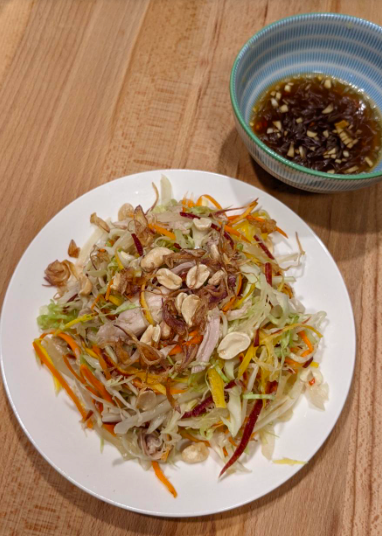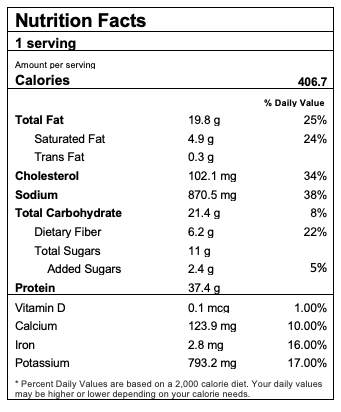Chicken salad, or gỏi gà, is a Vietnamese dish commonly served at feasts or large gatherings. It features low-cost but nutrient-dense ingredients–chicken, cabbage, carrots, and peanuts. It utilizes staples in Vietnamese and Southeast Asian cooking such as fish sauce (nước mắm), garlic, lime, and Thai chili pepper.
The salad embodies central characteristics of Vietnamese cuisine: “fresh ingredients, minimal cooking” [i], minimal dairy and oil, with interesting textures [ii]. Ingredients used in Vietnamese cooking are primarily those that grow easily given the agricultural conditions (e.g. rice), and those that make for dishes with cooling effects to combat the hot weather [i].
In Vietnamese cuisine, rice is usually the center of the meal, accompanied by various side dishes that add both nutrition and flavor to the dish. In the case of gỏi gà, the chicken adds protein, the peanuts fat, and the vegetables and aromatics vitamins, minerals, and antioxidants.
Fish sauce, or nước mắm, is another staple, contributing to the flavors of most Vietnamese dishes. Mixing with lime and sugar is a common way to enhance the flavor by adding a bit of sourness and sweetness to balance out the deep umami, and to lessen the fishy smell. Fish sauce has been found to deliver the same umami, salty flavor at a lower sodium level than using table salt, making it a lower-sodium seasoning option [iii]. If sodium is a concern, low-sodium soy sauce or coconut aminos can be a nice swap, albeit at a slightly different flavor profile.
The recipe for gỏi gà typically makes a large enough serving for you to share with your loved ones, or store for future meals.
This recipe is adapted from CET.edu [iv].
Ingredient Highlights
Chicken: Chicken is a good source of lean protein. Our body requires proteins to repair tissues and maintain the immune system, and this is especially important during cancer treatment. Diets lacking in protein can lead to muscle breakdown, which can prolong recovery and increase risks for infection [v].
Cabbage: Cabbage is a good source of potassium, vitamin C, vitamin K, and fiber, along with other antioxidants and phytochemicals. Its nutrient profile suggests anti-inflammatory and heart-protective properties [vi].
Carrots: Carrots are a good source of vitamin A, vitamin C, and antioxidants such as carotenoids. Available in different colors, these vegetables help combat oxidative stress and support your immune system [vii].
Peanuts: Small but mighty, peanuts are a good source of plant-based proteins and unsaturated fats, the “good” fat that can help improve your cholesterol profile [viii].
Onion and garlic: Members of the allium family, these vegetables are high in antioxidants such as allicin and quercetin, which have been shown to aid in the prevention of cancer and management of high cholesterol, diabetes, and hypertension [ix].
Recipe
Vietnamese Chicken Salad (Gỏi gà)
Serves: 4
Preparation time: 20 minutes of active preparation (more if slicing vegetables from fresh) + 45 minutes of wait time

Ingredients
- 1 lb boneless or 1.5 lb bone-in chicken
- 1 thumb-sized knob of ginger
- ½ head of green cabbage, shredded (can mix in purple cabbage for color)
- 2 carrots, shredded
- 1 medium onion
- 3 Tbsp fish sauce
- 1 lime or ~4 Tbsp lime juice
- 2 tsp sugar
- 1 tsp chopped garlic
- ½-1 Thai chili pepper (optional)
- ¼ cup roasted, unsalted peanuts
Instructions
1. Cook the chicken
- Bring a pot of water to a boil.
- Peel and cut the ginger into small chunks.
- Once the water boils, reserve a few Tbsp of boiled water for the dressing.
- Add the chicken and ginger into the pot and let boil until the chicken is fully cooked.
- Once done, remove the chicken from the pot and let cool down slightly. If you used bone-in chicken, the broth can be saved to serve with vermicelli noodles.
2. Prepare the vegetables
- While the chicken is boiling, wash the vegetables.
- Thinly slice onions, then soak in ice cold water to lessen the pungency.
- Shred or thinly slice the cabbage and carrots.
- Add the shredded vegetables into a large bowl along with Vietnamese coriander.
- Finely chop some garlic and Thai chili pepper. Set aside for the dressing.
3. Make the salad dressing
- In a bowl, combine fish sauce, lime juice, 3 Tbsp lukewarm water (reserved from step 1), sugar, chopped garlic and a little Thai chili pepper.
- Stir until the sugar is dissolved.
- Taste and adjust–we are aiming for a balance of umami, acidity, and mild sweetness. This will vary depending on your flavor preferences and the specific nước mắm that you have.
4. Shred the chicken
- Once the cooked chicken has cooled down slightly, shred the chicken into small pieces. You can also use 2 forks if it’s still too hot to the touch.
- Add the chicken to the vegetables.
5. Combine
- Add the dressing in batches to the vegetables and shredded chicken, toss to combine. (Taste as you go–you wouldn’t want to add too much dressing, as the flavor will intensify the longer the salad sits).
- Let the salad sit for 15 minutes for the flavors to get to know one another.
- Transfer to plate to serve. Sprinkle some roasted peanuts on top.
6. Serve
- For a more filling meal, serve the salad with white rice (or brown rice for more fiber).
- Alternatively, you can also serve it with mung bean vermicelli:
- Cook the vermicelli according to instructions.
- Heat up the broth used to boil chicken. Season to taste with fish sauce (keep in mind the flavor of the salad, so the dish does not turn out too salty).
- Add vermicelli to a bowl, ladle in some broth, and top with the chicken salad.
Notes:
- For faster preparations, you can get a coleslaw mix or pre-shredded cabbage and carrots and use leftover chicken.
- For softer texture, you can blanch the cabbage and carrots, and omit peanut.
- For lower sodium, you can try low-sodium soy sauce or coconut aminos, but they would offer a slightly different flavor.
- If dietary fat is a concern, you can remove chicken skin before cooking.
- If peanut allergy is a concern, chopped pretzels can provide the same crunch [x].
- If higher fiber is desired, you can choose brown rice instead of white rice.
- If you live near an Asian market, try finding Vietnamese coriander/cilantro (rau răm). These are different from the coriander or cilantro that we typically see, and would add an interesting herby flavor! Another item to look for is fried shallots. They come pre-fried and work great as a topping to many dishes.

References:
[i] Avieli N. (2011). Making sense of Vietnamese cuisine. Association for Asian Studies. Retrieved September 6, 2022, from https://www.asianstudies.org/publications/eaa/archives/making-sense-of-vietnamese-cuisine/
[ii] Vietnamese cuisine. Wikipedia. Retrieved September 6, 2022, from https://en.wikipedia.org/wiki/Vietnamese_cuisine
[iii] Huynh H. L., Danhi R., Yan S. W. (2016). Using fish sauce as a substitute for sodium chloride in culinary sauces and effects on sensory properties. J Food Sci. Retrieved September 7, 2022, from https://doi.org/10.1111/1750-3841.13171
[iv] Chef L. (n.d.). Cách Làm Gỏi Gà Xé Phay Đơn Giản Mà Ngon Hết Ý. CET.edu.vn. Retrieved September 6, 2022, from https://www.cet.edu.vn/cach-lam-goi-ga-xe-phay
[v] The American Cancer Society medical and editorial content team. (2022, March 16). Benefits of good nutrition during cancer treatment. Cancer.org. Retrieved September 6, 2022, from https://www.cancer.org/treatment/survivorship-during-and-after-treatment/coping/nutrition/benefits.html
[vi] Benefits of Cabbage. Cleveland Clinic. Retrieved September 6, 2022, from https://health.clevelandclinic.org/benefits-of-cabbage/.
[vii] What are the health benefits of carrots? MedicalNewsToday. Retrieved September 6, 2022, from https://www.medicalnewstoday.com/articles/270191
[viii] What are the nutritional benefits of peanuts? MedicalNewsToday. Retrieved September 6, 2022 from https://www.medicalnewstoday.com/articles/325003
[ix] Wan Q., Li N., Du L., et. al. (2019). Allium vegetable consumption and health: An umbrella review of meta-analyses of multiple health outcomes. Food Sci Nutr. Retrieved September 6, 2022, from https://www.ncbi.nlm.nih.gov/pmc/articles/PMC6694434/
[x] Recipe substitutions for peanuts and tree nuts. Kids with Food Allergies. Retrieved September 7, 2022, from https://www.kidswithfoodallergies.org/peanut-nut-allergy-recipe-substitutions.aspx
